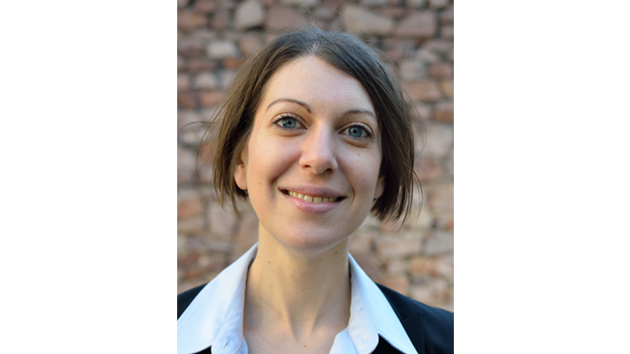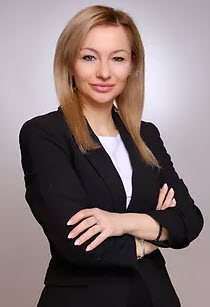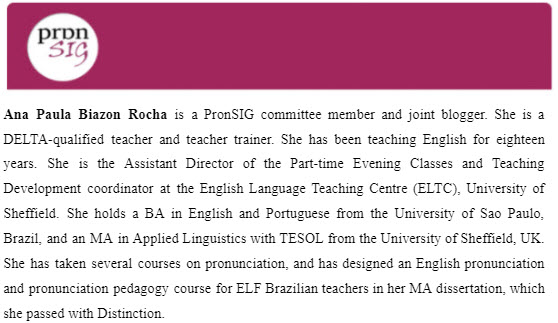by Ana Paula Biazon Rocha
Among the “WH-issues of pronunciation instruction” (I’m coining the expression, what do you think?!), namely why, how and when to teach pronunciation and what to teach, which are the cornerstones of the PronSIG’s blog posts, there is an undoubtedly pressing one: how to assess pronunciation. Assessment in language teaching and learning is pivotal yet challenging and may scare many teachers and learners away. Doing tests and sitting exams are the stereotypical images that tend to come to mind and may cloud our judgement in terms of the real objectives and functions of assessing one’s linguistic competence, especially in relation to pronunciation. Accordingly, PronSIG’s October Conference in association with TEASIG (Testing, Evaluation and Assessment Special Interest Group) on 01 October 2022 (click here to register), will focus on Exploring effective pronunciation assessment practices in the English language classroom, a topic chosen by you, PronSIG’s audience, in a poll organised in our social media earlier this year. Thus, in this post, we will briefly review some general ideas on pronunciation assessment and get to know a bit more about our two plenary speakers, Talia Isaacs and Tanja Angelovska.
Isbell and Sakai (2022, p. 195) define assessment as “the process of collecting information to make an informed judgement for some purpose. While all tests are assessments, not all assessments are tests”. In other words, although tests and exams are common formal assessment tools, we assess learners in the classroom whenever we observe how they perform a certain task or use the content taught to produce language orally or in written form. In the same vein, Isaacs (2018, p. 274) reminds us that the term assessment can be interpreted “to denote any information-gathering activity that is used to make conclusions about an individual’s language ability (…) or that may be used to extrapolate other (nonlinguistic) characteristics of that person”.
As a result, when it comes to pronunciation assessment, we are not necessarily referring to a pronunciation test where learners have to choose the correct vowel sound in a word, mark the correct intonation pattern in a question or pronounce a given sentence accurately, even though in certain contexts and circumstances this might be the case, but to ways in which we can analyse how intelligible our students’ pronunciation is. As one of the main goals of pronunciation teaching is intelligibility (click here for a definition of intelligibility), so is the focus of pronunciation assessment (Isbell & Sakai, 2022). Consequently, Derwing and Munro (2015, p. 110) explain that “the purpose of assessment is not solely to identify what one does wrong – it is about what matters for communication”. In fact, our pronunciation is assessed every time we speak because if someone does not understand what we are saying, we have proof that we may be speaking less clearly than is necessary, meaning we have to quickly change or adapt it to be understood, and let communication flow effectively.
In the classroom, pronunciation assessment can take place in different ways such as diagnostic testing, achievement testing, performance assessment, progress tests and quizzes and self-assessment (Isbell & Sakai, 2022) (for further details click here). However, as many teachers need better support and training on how to teach pronunciation (Derwing and Munro, 2015; Levis et al., 2022), they also need help on how to assess learners’ pronunciation (Isbell & Sakai, 2022), and that is why PronSIG’s October Conference is of utmost importance (click here to check the conference schedule and programme).
One of the plenary speakers of PronSIG’s conference is Talia Isaacs, an expert in pronunciation assessment. Isaacs is an Associate Professor of Applied Linguistics and TESOL and Programme Leader for the MA TESOL In-Service at the UCL Centre for Applied Linguistics, University College London. She has published several articles and presented many talks on pronunciation assessment throughout the years. Along with Pavel Trofimovich, she has edited the seminal book Second Language Pronunciation Assessment: Interdisciplinary Perspectives (2017, Multilingual Matters). She has a way of explaining complex topics in such a didactic way that can make us feel much more confident when assessing our student’s pronunciation. In our conference, she will try and bridge the gap between pronunciation assessment research and practice. The title of her plenary is Letting go of baggage? Reconceptualising pronunciation and assessment for pedagogical practice, and we are looking forward to it! (click here for further information on Talia Isaacs)

The other plenary speaker in PronSIG’s October Conference is Tanja Angelovska, an expert in multilingualism and teaching and learning English as a third language. She is an Associate Professor of English Linguistics & Language Education at the University of Salzburg and an associate Editor of Ampersand: An Interdisciplinary Journal of Language Sciences and Bilingualism. Similar to Isaacs, Angelovska has authored several articles and presented in numerous conferences. Along with Angela Hahn, Angelovska has edited the seminal book L3 Syntactic Transfer Models, new developments and implications (2017, John Benjamins). It is fascinating to learn from her research how L3 learning and teaching happen considering that in multilingual classes worldwide, many of our learners might be learning English as a third language, not necessarily as a second one, according to their cultural and linguistic background. In our conference, she will clarify questions on pronunciation assessment and make pedagogical recommendations. The title of her plenary is Pronunciation assessment for the foreign language classroom: some challenges and practical solutions, and we are also looking forward to it! (click here for further information on Tanja Angelovska)

Therefore, as you can see, learning and reflection on pronunciation assessment abound. Hopefully, PronSIG’s October Conference will help you with it through the insights of our great plenary speakers, Isaacs and Angelovska, and all the other equally great presenters who will take part in it. We hope to see you there!
Don’t forget to follow PronSIG on social media and leave your comments below.
References
Derwing, T., & Munro, M. (2015). Pronunciation fundamentals: Evidence-based perspectives for L2 teaching and research. Amsterdam: John Benjamins.
Isaacs, T. (2018). ‘Shifting Sands in Second Language Pronunciation Teaching and Assessment Research and Practice’, Language Assessment Quarterly, 15(3), p. 273-293.
Isbell, D. R., & Sakai, M. (2022). Pronunciation Assessment in Classroom Contexts. In J. Lewis, T. Derwing, T. & S. Sonsaat-Hegelheimer (eds.) Second Language Pronunciation. Bridging the Gap Between Research and Teaching. Hoboken and West Sussex: Wiley Blackwell. p. 194-214.
Levis, J., Derwing, T. & Sonsaat-Hegelheimer, S. (2022). Second Language Pronunciation. Bridging the Gap Between Research and Teaching. Hoboken and West Sussex: Wiley Blackwell.


